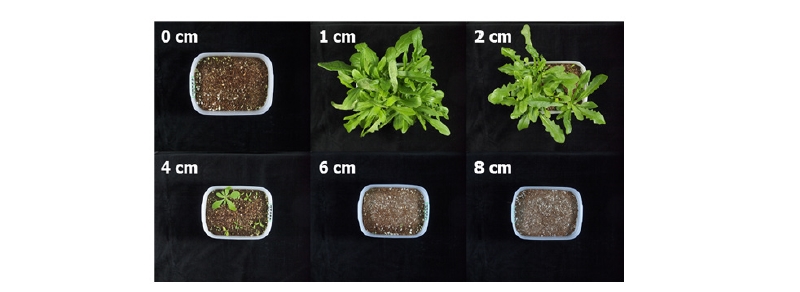2019년 6월 현재, 국내에는 식물 14종, 동물 6종이 생태계교란종으로 지정되어 있다. 2015년 보고된 농경지 잡초 조사 결과에 따르면, 생태계교란식물 14종 중 9종이 농경지에서 발생하고 있었다(Lee et al., 2015). Kim et al. (2017a)은 국내 농경지 내 생태계교란식물의 분포를 분석한 결과, 돼지풀(Ambrosia artemisiifolia L) 및 단풍잎돼지풀(Ambrosia trifida L) 등은 이미 농경지에 침입해 있고, 서양금혼초(Hypochaeris radicata L) 등은 과수원 등을 포함한 농경지에서 잡초화 될 가능성이 높다고 평가하였다. 일부 종에 대해서는 방제법이 연구되어 있지만(Moon et al., 2002; Yoo et al., 2008), 대부분 종에 대해서는 국내 방제실험결과가 보고되어 있지 않다.
서양금혼초는 국화과 다년생 식물로 유럽의 모로코가 원산지로 알려져 있다(Ortiz et al., 2008). 형태적으로 서양민들레(Taraxacum officinale L)와 유사하여 개민들레’ 혹은 민들레아재비’, 영어로는false dandelion’으로 불리기도 한다. 곤충을 매개로 수정하며(Aarssen, 1981), 종자에는 흰색 관모(papus)가 있어 바람에 날려 확산한다. 보통은 100 m 이내로, 최대 400 m까지 비산할 수 있다(Soons and Heil, 2002). 국내에는 제주도에 많이 분포하고 있으며(Lee et al., 2016), 목포, 군산, 태안 등 서해안(Kim et al., 2017b)과 부산, 울산 등 동남해안(Song et al., 2018)을 따라 북상 또는 내륙으로 확산하고 있는 것으로 파악된다. 아직까지는 길가나 공터에 분포하고 있지만 과수원 등으로 침입할 가능성이 매우 높은 것으로 판단되며, 이를 대비한 방제법이 필요하나 아직까지 서양금혼초의 방제에 대해 연구된 바가 없다. 따라서 서양금혼초의 체계적인 방제를 위해 발아특성을 검정하고자 본 연구를 수행하였다.
서양금혼초 종자는 2017년 10월 군산에서 채집했으며, 관모를 제거한 후에 실험에 사용하였다. 온도에 따른 서양금혼초의 발아특성을 확인하고자, 다음과 같은 실험을 진행하였다. 90 mm 페트리디쉬에 물을 적신 거름종이를 깔고, 그 위에 정선한 서양금혼초 종자 100립을 파종한 후 밀봉하였다. 밀봉한 페트리디쉬는 Bio Multi-Incubator (LH-300CCFL-8CT, NK system, Japan)에서 발아시켰다. 처리 조건은 정온조건으로 10, 15, 20, 25, 30 및 35℃였고, 변온조건으로 15/10, 20/15, 25/20, 30/25, 20/10, 25/15 및 30/20℃ (주/야)였으며, 각 4반복이었다. 광주기는 12/12 h (주/야)였고, 광량은 51.3±2.7 μmol s-1 m-2였다. 2일 간격으로 물을 갈아주며 발아개체수를 조사하였고 파종 후 21일차에 최종발아율을 조사하였다.
토양심도에 따른 발아특성을 확인하기 위해 플라스틱 사각 포트(19 cm×13 cm×10.5 cm)에 실험용 토양(원예용 상토 : 못자리용 상토=1:1 (v/v))을 토양심도0(표면), 1, 2, 4, 6 및 8 cm가 되도록 채웠다. 그 후, 정선된 서양금혼초 종자 100립을 파종하고 토양심도 0 cm에 맞춰 복토하였다. 파종 후 56일에 발아개체수, 엽수 및 생체중를 조사하였으며, 반복은 4반복이었다. 모든 통계분석은 SAS 9.4 (SAS Institute Inc., Cary, N.C., USA)를 사용하였다.
서양금혼초는 정온조건에서 20℃까지 발아율이 100%로 최대였으며, 25℃보다 높은 온도에서는 유의적으로 감소하였다(Fig. 1A). 5℃ 및 10℃ 차이의 변온조건에서도 온도가 증가함에 따라 발아율이 감소하였으나 정온조건에서의 감소폭은 아니었고, 낮 기온이 같을 때, 10℃ 차이 보다는 5℃ 차이가 발아율이 더 높았다(Fig. 1B). 이상의 실험결과로 볼 때, 10-20℃가 서양금혼초의 발아에 적합한 온도범위로 판단되며, 20/15℃ (주/야) 조건이 서양금혼초의 발아적온으로 볼 수 있었다.
독일에서 실시한 서양금혼초의 발아실험 결과, 최저 발아온도는 6℃ 내외였다(Rosbakh and Poschlod, 2015). 대한민국의 순평균온도(http://www.weather.go.kr/)를 고려하면 서양금혼초는 3월 초·중순에 발아를 시작해서 5월 중순까지 꾸준하게 발아할 것으로 추정할 수 있었다. 따라서 서양금혼초의 발아를 방지하기 위해서는 적절한 토양처리제를 3월 이전에 처리해야 하며 그 지속기간은 최소 2개월은 유지되어야 할 것이다. 서양금혼초의 생태적 특성을 고려했을 때, 옥시플루오르펜(oxyfluorfen)이나 디클로베닐(dichlobenil) 등이 방제를 위한 토양처리제로 매우 효과적일 것으로 판단되며, 약제선발 및 방제실험으로 검증하여 서양금혼초 방제를 위한 체계처리의 한 일환으로 사용되어야 할 것이다.
서양금혼초는 토양표면에서 발아하지 않았고(토양심도 0 cm), 주로 1-4 cm에서 발아하였으며, 최대 6 cm에서도 발아하였다(Table 1; Fig. 2). 심도 1-2 cm에서 유의적인 차이 없이 발아율이 가장 높았다. 서양금혼초의 발아 적정심도는 1-2 cm로 판단되었으며, 8 cm 이상에서는 발아할 수 없음을 확인하였다. 적정심도는 국화과 개쑥갓(Senecio vulgaris L.)과 비슷했으나, 개쑥갓보다 2 cm 이상 깊은 곳에서도 발아할 수 있는 것으로 판단되었다(Kim et al., 2018). 위의 결과로부터 1-4 cm 사이에서 종자가 발아하는 것으로 추정할 수 있으며, 발아한 유식물의 물리적 방제법으로는 5 cm 내외의 얕은 경운이 효과적일 것으로 판단된다. 글루포시네이트(glufosinate) 및 글리포세이트(glyphosate)와 같은 비선택성 제초제를 사용한 화학적 방제법도 효과적일 것으로 판단된다.
서양금혼초는 자가수분과 타가수분이 모두 가능한 잡초이다. 자가수분을 할 경우, 종자생산량이 떨어지고 관모가 짧고 작아져 넓게 확산하지 못하고 소군락을 이루게 되며, 타가수분을 할 경우는 그 반대 현상이 일어나 급속한 확산이 이루어진다(Picó et al., 2004). 2018년 현재, 서양금혼초는 제주도에 높은 밀도로 분포하고 있으며, 그 외에 목포, 무안 등 서남해안과 부산의 동남해안을 따라 제한적으로 분포하고 있다(Kim et al., 2017a). 아직까지 농경지로의 침입은 거의 없는 것으로 판단되나, 자가 및 타가수분이 모두 가능하고 다년생인 서양금혼초가 서양민들레와 같이 과수원 등으로 침입하게 되면 서양민들레 이상의 피해를 줄 수 있을 것으로 판단된다. 따라서 본 연구에서 확인한 서양금혼초의 발아특성을 기초로 하여 방제전략을 수립한다면 그 피해를 최소화 할 수 있을 것으로 판단된다.
생태계교란생물은 생태계에 한 번 침입하게 되면 확산 속도가 매우 빠르고 완전 제거가 매우 어려우며, 제거를 위한 많은 노력이 필요하다. 이러한 생태계교란식물이 농경지에서 잡초화 된다면 이를 생태계교란잡초(Invasive alien weeds)’로 정의할 수 있으며, 이는 주변의 환경적으로 생태계에 악영향을 끼칠 뿐 아니라, 경제적으로 농업경영인에게 막대한 피해를 줄 수 있다. 이미 발생하고 있는 생태계교란잡초뿐만 아니라 잠재적으로 피해를 줄 수 있는 생태계교란잡초들에 대해 생리·생태 및 방제 등 다각적인 접근과 연구를 통해 그 피해를 최소화 할 수 있도록 해야 할 것이다.





